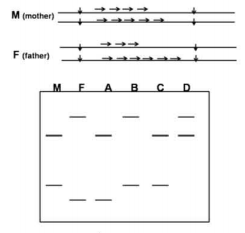 Multiple Choice Questions
Multiple Choice QuestionsThe following table shows the mean and variance of population densities of species A, B, and C.
| Statistic | Species A | Species B | Species C |
| Mean | 5.30 | 7.05 | 5.30 |
| Variance s2 | 5.05 | 0.35 | 50.5 |
Based on the above, which of the following statements is correct?
Species A and B show uniform distribution, whereas species C shows clumped distribution.
Species A shows the random distribution, species B shows uniform distribution, and species C shows clumped distribution.
Species A and B show clumped distribution, whereas species C shows uniform distribution.
Species A shows the clumped distribution, species B shows the random distribution, and species C shows uniform distribution.
If gypsy moth egg density is 160 at time t and 200 at t + 1, what will be its value at time t + 3, assuming that egg density continues to increase at constant rate?
250
280
312
390
Constitutive photomorphogenesis (COP1) protein, an E3 ubiquitin ligase, regulates the turnover of proteins required for photomorphogenic development. Following are certain independent statements related to the function of COP1 protein:
A. In light, COP1 along with SPA1 ads ubiquitin tags to a subset of nuclear proteins.
B. The proteins ubiquitinated by COP1 and SPA1 are targeted for degradation by the 26S proteasome.
C. In dark COP1 is slowly exported to the cytosol from the nucleus.
D. The absence of COP1 in the nucleus permits the accumulation of transcriptional activators necessary for photomorphogenic development.
Which one of the following combinations is correct?
A and C
A and D
B and C
B and D
Influenza virus (IV), a well known enveloped animal virus, enters its host cells through membrane fusion process catalyzed by hemagglutinin (HA) protein inside endosomes at 37°C. HA is localized in the lipid bilayer membrane of the IV as an integral membrane protein and is responsible for binding and fusion of IV membrane with the endosomal membrane of host cells. Upon binding, IV is internalized into host cells through receptor-mediated endocytosis followed by fusion of the IV membrane with endosome membrane catalyzed by HA. In a situation, if we wish to fuse IV membrane with its host cells (deficient in endocytosis) at the plasma membrane, mention the correct condition out of the following:
Pre-treat IV in pH 5.0 followed by its binding and fusion with host cells at pH 7.4 and 37°C.
Allow the IV to bind and fuse with host cells at pH 7.4 and 37°C.
IV and host cells are allowed to bind and fuse at pH 5.0 and 37°C.
IV is subjected to incubation at 60°C for 30 minutes and allowed to bind and fuse with host cells at pH 5.0 and 37°C.
It is well established that "Band 3" protein of red blood cell membrane is solely responsible for Cl- transport across the membrane. A lysine group in the Cl- binding site of "Band 3" is crucial for this event. Keeping this in mind what is the most appropriate way to load and retain a small anionic fluorescent probe (x) inside the red blood cells (RBCs) suspended in phosphate-buffered saline (PBS), pH 7.4.
Incubate the RBCs with x in phosphate-buffered saline (PBS, pH 7.4) at 37°C for 30 min.
Incubate the RBCs with x in PBC at 4°C for 30 min.
Incubate the RBCs with x in Hepes sulfate buffer (pH 7.4) at 37°C for 30 min.
Incubate the RBCs with x in Hepes sulfate buffer (pH 7.4) at 37°C for 30 min followed by treatment with a NH2 group modifying agent (covalent modification).
Minisatellites are used as marker for identifying individuals via DNA fingerprinting as the alleles may differ in the number of repeats. From the Southern blot shown below identify the progeny (A, B, C, and D) for the given parents (M = Mother, F = Father).

A, B, C, and D
A, B, and D
A and D only
B, C, and D
Which one of the following statements is correct for amplified-fragment length polymorphism (AFLP)?
PCR using a combination of random and gene-specific primers.
PCR amplification followed by digestion with restriction enzymes.
Digestion of DNA with restriction enzymes followed by one PCR step.
Digestion of DNA with restriction enzymes followed by two PCR steps.
D.
Digestion of DNA with restriction enzymes followed by two PCR steps.
The correct statement is-
Digestion of DNA with restriction enzymes followed by two PCR steps.
Which one of the following can be analysed using Surface Plasmon Resonance method?
Radiolabelled DNA probes
Protein structure
Optical density of a solution
Label-free bimolecular interaction
A solid contains a spherical cavity. The cavity is filled with a liquid and includes a spherical bubble of gas. The radii of cavity and gas bubble are 2mm and 1mm, respectively. What proportion of the cavity is filled with liquid?
